Top 10 Oldest Buildings In The World - The First Buildings
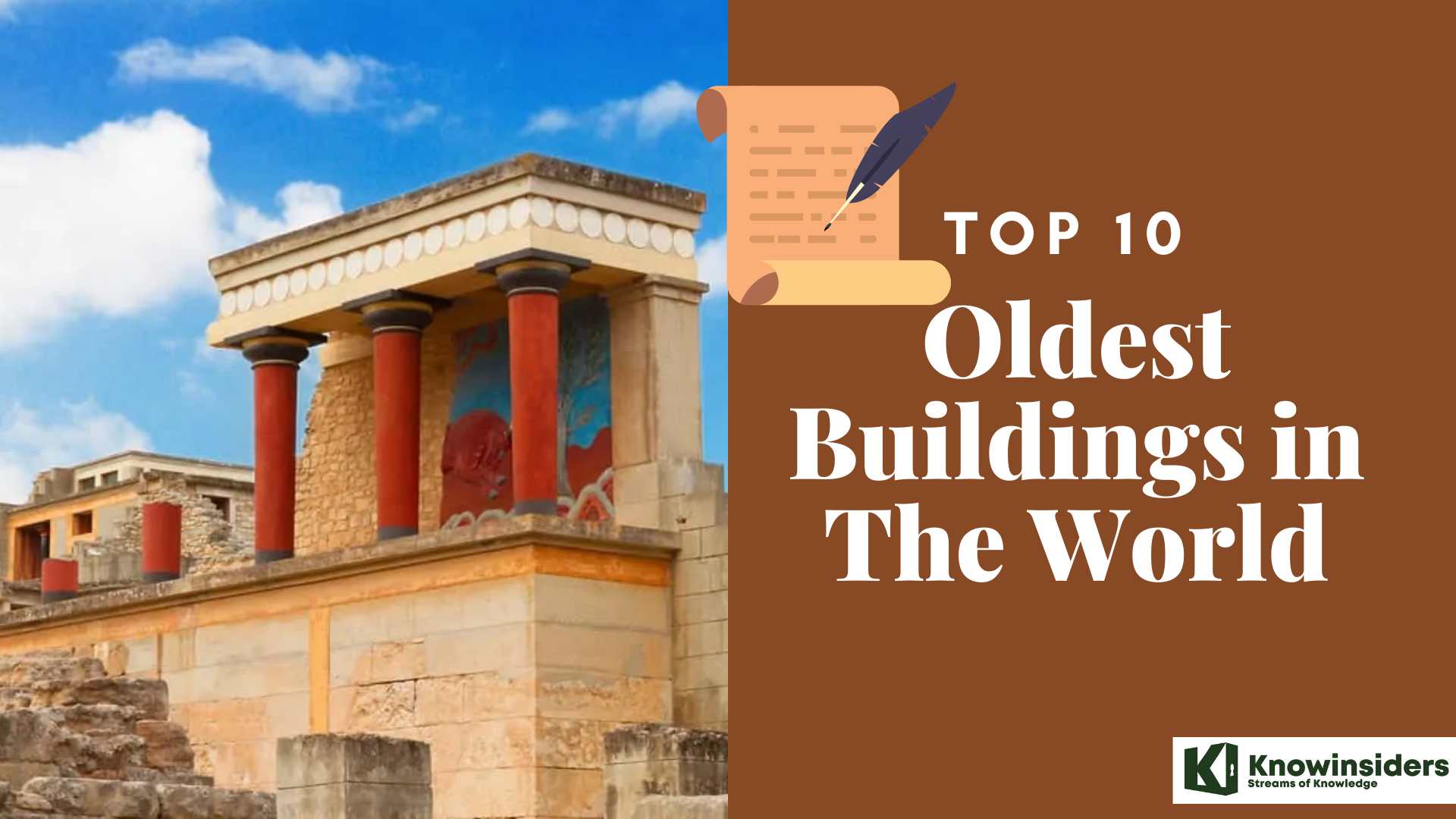 |
| Top 10 oldest buildings in the world |
Building is defined as any human-made structure used or intended for supporting or sheltering any use or continuous occupancy. The extant freestanding buildings constructed in the world which are the masterpiece of the skill and handwork of the people of that era. Today we become astonished to see these wonders that in so remote ages without any modern technology and machine how so great construction were made.
These are the 10 Oldest Buildings in the world.
The List of top 10 oldest buildings in the world
10. Treasury of Atreus, Greece
9. Minoan Palace of Knossos, Greece
8. Great Pyramid of Giza, Egypt
7. Pyramid of Djoser, Egypt
6. Tarxien Temples, Malta
5. Newgrange, Ireland
4. La Hougue Bie, Jersey
3. Knap of Howar, Scotland
2. Megalithic Temples of Malta
1. Tumulus of Bougon, France
***
What Are The Top 10 Oldest Buildings in the World?
10. Treasury of Atreus
 |
| Photo: GJC Classical Art History |
The Treasury of Atreus or Tomb of Agamemnon is a large tholos or beehive tomb on Panagitsa Hill at Mycenae, Greece, constructed during the Bronze Age around 1250 BC. The stone lintel above the doorway weighs 120 tons, with approximate dimensions 8.3 x 5.2 x 1.2m, the largest in the world. The tomb was used for an unknown period. Mentioned by the Roman geographer Pausanias in the 2nd century AD, it was still visible in 1879 when the German archaeologist Heinrich Schliemann discovered the shaft graves under the "agora" in the Acropolis at Mycenae.
The tomb perhaps held the remains of the sovereign who completed the reconstruction of the fortress or one of his successors. The grave is in the style of the other tholoi of Mycenaean Greece, of which there are nine in total around the citadel of Mycenae and many more in the Argolid. However, in its monumental shape and grandeur it is one of the most impressive monuments surviving from the Mycenaean period.
The tomb has probably no relationship with either Atreus or Agamemnon – legendary rulers of Mycenae or Argos in the works of Homer, in the Epic Cycle, and the Oresteia – as archaeologists believe that the Mycenaean sovereign buried there ruled at an earlier date than king; it was named thus by Heinrich Schliemann and the name has been used ever since. The historicity of the Trojan War, to which Schliemann sought to connect both Mycenae and Hisarlik, is a matter of long-standing and ongoing debate.
9. Minoan Palace of Knossos, Greece
 |
| Photo: Sofia Adventures |
The Minoan Palace of Knossos in Crete, Greece: The Minoan Palace at Knossos is over 20,000 square meters and the largest of all Minoan palatial structures. It was built of ashlar blocks, had many floors and was decorated with really beautiful frescoes. The old palace was built around 2,000 BC but was destroyed by an earthquake in 1700 BC. The newer, more complex palace, was built almost immediately after the first one was destroyed. In the middle of the 15th Century BC, the Achaeans took over the island of Crete and settled in the palace. The palace was once again destroyed by fire in the middle of the 14th Century B.C and henceforth ceased to function as a palatial center.
The first excavations that brought to light parts of the palace were carried out by Minos Kalokairinos, a Cretan merchant and antiquarian in 1878. Several other people attempted to continue the excavations including W.J Stillman, the American Consul in Greece, M Joubin, a French archaeologist and Arthur Evans, director of the Ashmolean Museum in Oxford.
However, they all had to abandon their efforts as they were unwilling to purchase the area at the extremely high prices that the owners asked for it. Eventually in 1898, when Crete became an independent state, all the antiquities of the island became state property and in 1900, excavations on the site started under the supervision of Arthur Evans.
8. Great Pyramid of Giza, Egypt
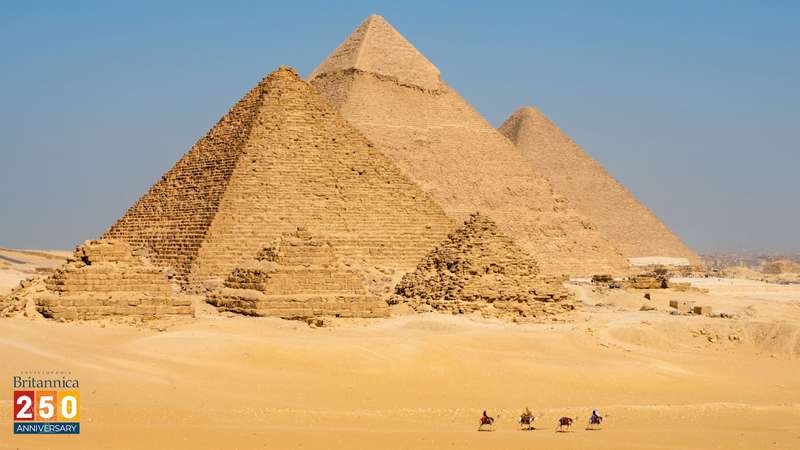 |
| Photo: Britannica |
The Great Pyramid of Giza (also known as the Pyramid of Khufu or the Pyramid of Cheops) is the oldest and largest of the pyramids in the Giza pyramid complex bordering present-day Giza in Greater Cairo, Egypt. It is the oldest of the Seven Wonders of the Ancient World, and the only one to remain largely intact.
Egyptologists conclude that the pyramid was built as a tomb for the Fourth Dynasty Egyptian pharaoh Khufu and estimate that it was built in the 26th century BC during a period of around 27 years.
Initially standing at 146.5 metres (481 feet), the Great Pyramid was the tallest man-made structure in the world for more than 3,800 years. Throughout history the majority of the smooth white limestone casing was removed, which lowered the pyramid's height to the present 138.5 metres (454.4 ft). What is seen today is the underlying core structure. The base was measured to be about 230.3 metres (755.6 ft) square, giving a volume of roughly 2.6 million cubic metres (92 million cubic feet), which includes an internal hillock.
There are three known chambers inside the Great Pyramid. The lowest was cut into the bedrock, upon which the pyramid was built, but remained unfinished. The so-called Queen's Chamber and King's Chamber, that contains a granite sarcophagus, are higher up, within the pyramid structure. Khufu's vizier, Hemiunu (also called Hemon), is believed by some to be the architect of the Great Pyramid. Many varying scientific and alternative hypotheses attempt to explain the exact construction techniques.
7. Pyramid of Djoser, Egypt
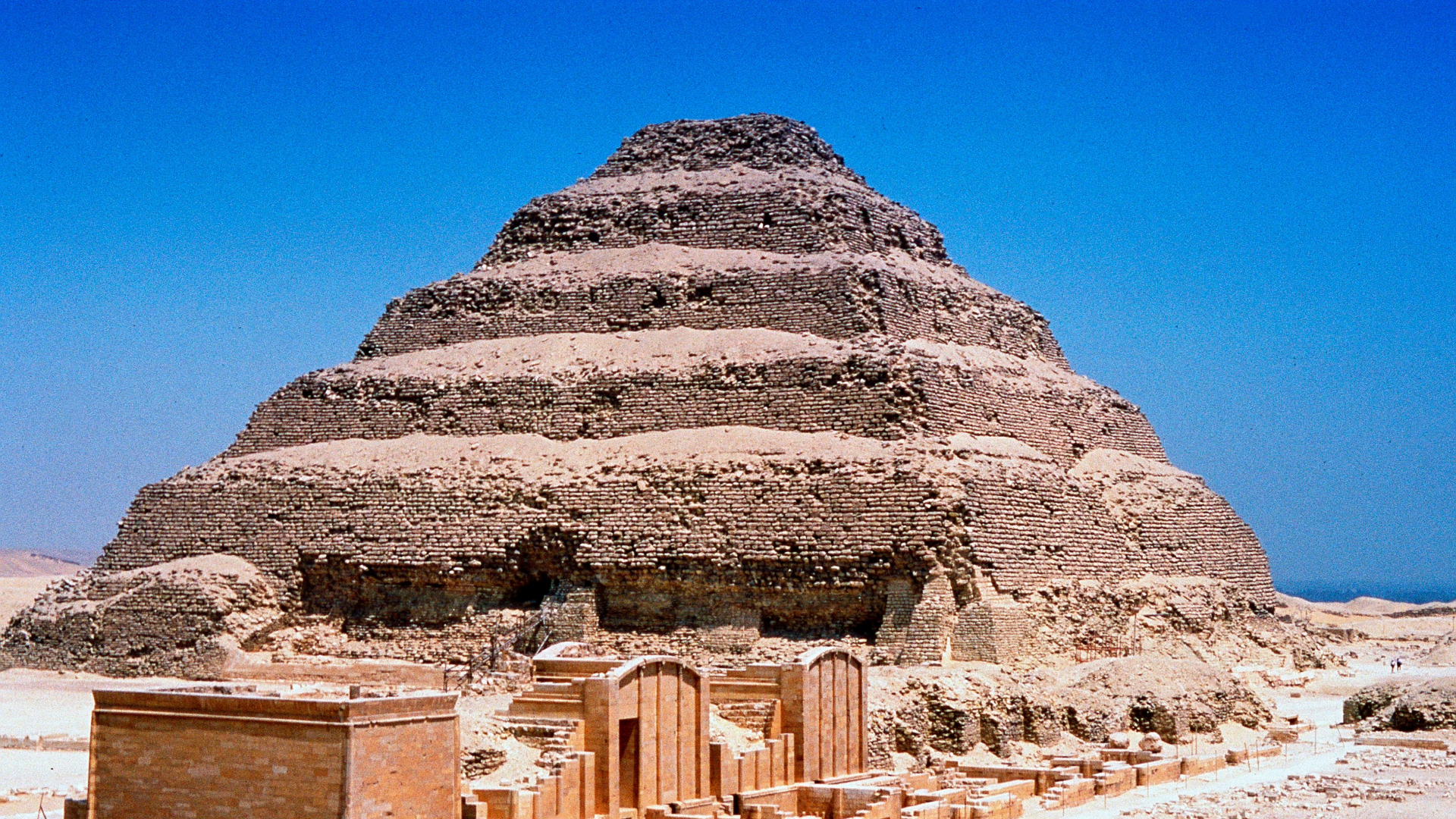 |
| Photo: ThoughtCo |
The Pyramid of Djoser, also known as the Step Pyramid, a UNESCO world heritage site, was reopened on March 5, after a restoration took 14 years and nearly $6.6 million.
An architect named Imhotep designed the pyramid more than 4,600 years ago to house the coffin of Pharoah Djoser. He decided, for the first time, to build up. He devised a new structure made of six layers of stone that got smaller as they ascended. The final product was meant to be a stairway to heaven.
It was the first building ever made of stone, and led the way to Egypt building more famous pyramids, like the Great Pyramid of Giza.
Over centuries its condition deteriorated due to the effects of time, neglect, fierce winds, and serious damage sustained in a 1992 earthquake.
And while fixing a crumbling stone pyramid is difficult, it was delayed for almost two years by Egyptian unrest. The restoration also faced scrutiny by Egyptian NGOs that claimed the work was actually making the pyramid worse.
6. Tarxien Temples, Malta
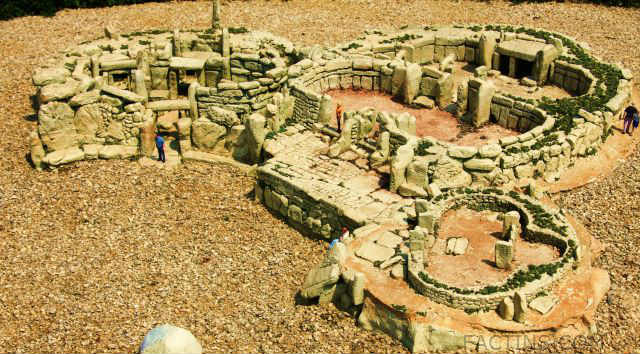 |
| Photo: Factins |
The Tarxien temples were built between 3600 and 2500 BC.
In this prehistoric period, the temples were used regularly for rituals including animal sacrifice, as attested by the discovery of a flint blade, a long bone spatula, animal bones, and seashells within a carved altar.
In the Bronze Age (2400-1500 BC), Tarxien was reused as a cremation cemetery.
The site lie hidden for centuries until its discovery in 1914, when farmers struck large stone blocks while ploughing a field. Sir Temistocles Zammit, Malta’s first director of museums, excavated the site in 1915-17.
The Tarxien temple complex consists of four temples connected by a square court. The temples each have separate entrances.
Uniquely, the central temple consists of six apses. This is the only known example of such a layout and it represents a final phase in the long evolution of Maltese temple architecture. A narrow staircase connects the central temple to the east temple.
The Tarxien temples are notable for their fine worksmanship and decorative carvings, which include domestic animals carved in relief, exquisite spiral designs, and other patterns. Especially impressive is a relief of two bulls and a sow between the South and Central temples.
The spiral is the most common design in megalithic art on Malta, and indeed around the world. Believed by some to represent eternity, the design is expressed in a wide variety of forms across the islands and clearly had a significant meaning for the ancient Maltese peoples.
Fertility goddess figures (now in the national museum in Valetta) discovered in the ruins indicate that the temples were dedicated to the Earth Mother, as were many Maltese temples. The most famous of these figures is a sculpture of large hips with feet, dubbed the "Fat Lady."
5. Newgrange, Ireland
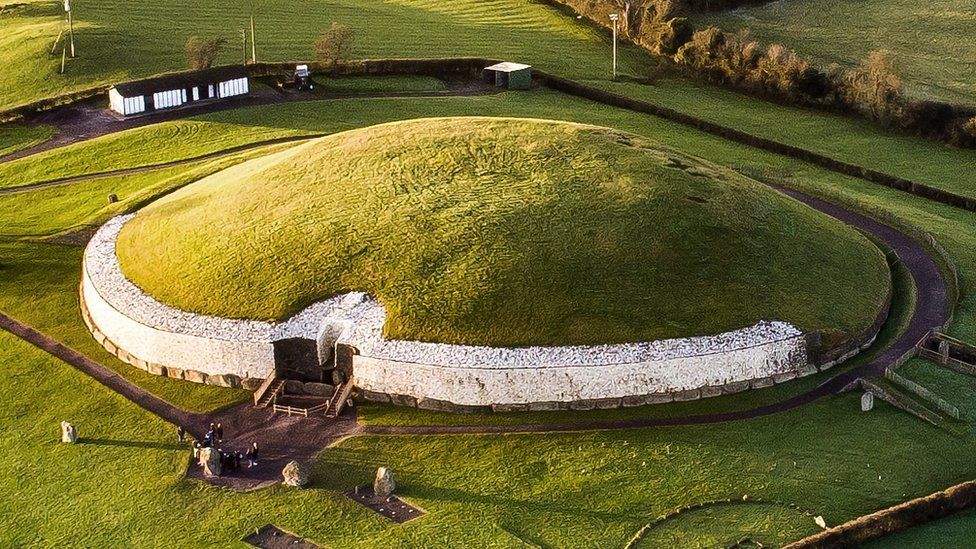 |
| Photo: BBC |
Newgrange (Irish: Sí an Bhrú) is a prehistoric monument in County Meath, Ireland, located 8 kilometres (5.0 mi) west of Drogheda on the north side of the River Boyne. It is an exceptionally grand passage tomb built during the Neolithic period, around 3200 BC, making it older than Stonehenge and the Egyptian pyramids.
The site consists of a large circular mound with an inner stone passageway and chambers. Human bones and possible grave goods or votive offerings were found in these chambers. The mound has a retaining wall at the front, made mostly of white quartz cobblestones, and it is ringed by engraved kerbstones. Many of the larger stones of Newgrange are covered in megalithic art. The mound is also ringed by a stone circle. Some of the material that makes up the monument came from as far away as the Mournes and Wicklow Mountains. There is no agreement about what the site was used for, but it is believed that it had religious significance. Its entrance is aligned with the rising sun on the winter solstice, when sunlight shines through a 'roofbox' located above the passage entrance and floods the inner chamber. Several other passage tombs in Ireland are aligned with solstices and equinoxes, and Cairn G at Carrowkeel has a similar 'roofbox'. Newgrange also shares many similarities with other Neolithic constructions in Western Europe, especially Gavrinis in Brittany, which has both a similar preserved facing and large carved stones, in that case lining the passage within. Maeshowe in Orkney, Scotland, with a large high corbelled chamber, and Bryn Celli Ddu in Wales have also been compared to Newgrange.
It is the most famous monument within the Neolithic Brú na Bóinne complex, alongside the similar passage tomb mounds of Knowth and Dowth, and as such is a part of the Brú na Bóinne UNESCO World Heritage Site. There are many smaller archaeological sites such as henges, mounds and standing stones situated in the .75 km between Newgrange and the Boyne. Newgrange consists of approximately 200,000 tonnes of rock and other materials. It is 85 metres (279 ft) wide at its widest point.
4. La Hougue Bie, Jersey
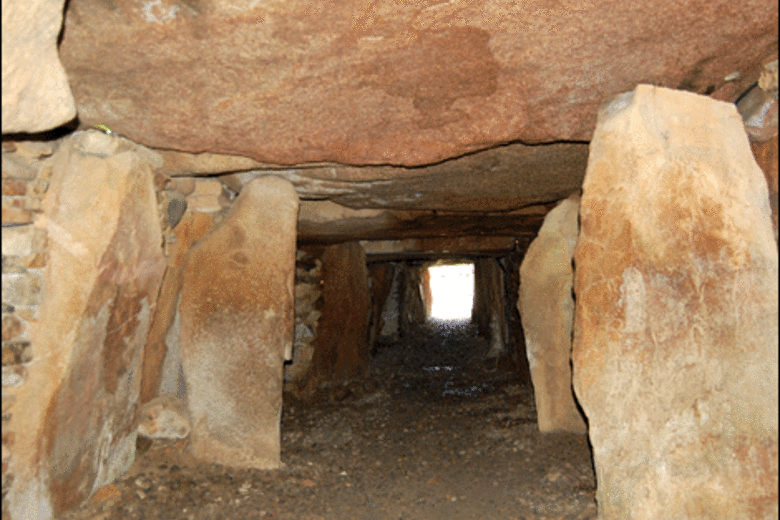 |
| Photo: Atlas Obscura |
La Hougue Bie is a historic site, with museum, in the Jersey parish of Grouville. La Hougue Bie is depicted on the 2010 issue Jersey 1 pound note.
Hougue is a Jèrriais/Cotentin variant form of the more common Norman form Hogue. It means "heap", "how", mound" and comes from the Old Norse word haugr meaning about the same thing. Bie is of uncertain origin. The legend of La Hougue Bie connects it with the Seigneur of Hambye in the Cotentin; an Old Norse origin may connect it to -by toponyms in Great Britain; or it may be connected to the Jèrriais word bié (variant spelling for biz "leat"). There are several hamlets called La Bie in Normandy (Ex La Bie, or La By(e), Grumesnil), that is never confused with Le Bié (Ex: Le Vieux-Bié, Les planters du Viez Bié, 1263, Gournay-en-Bray). La Hougue Bie refers probably to "a building on the earth mound".
3. Knap of Howar, Scotland
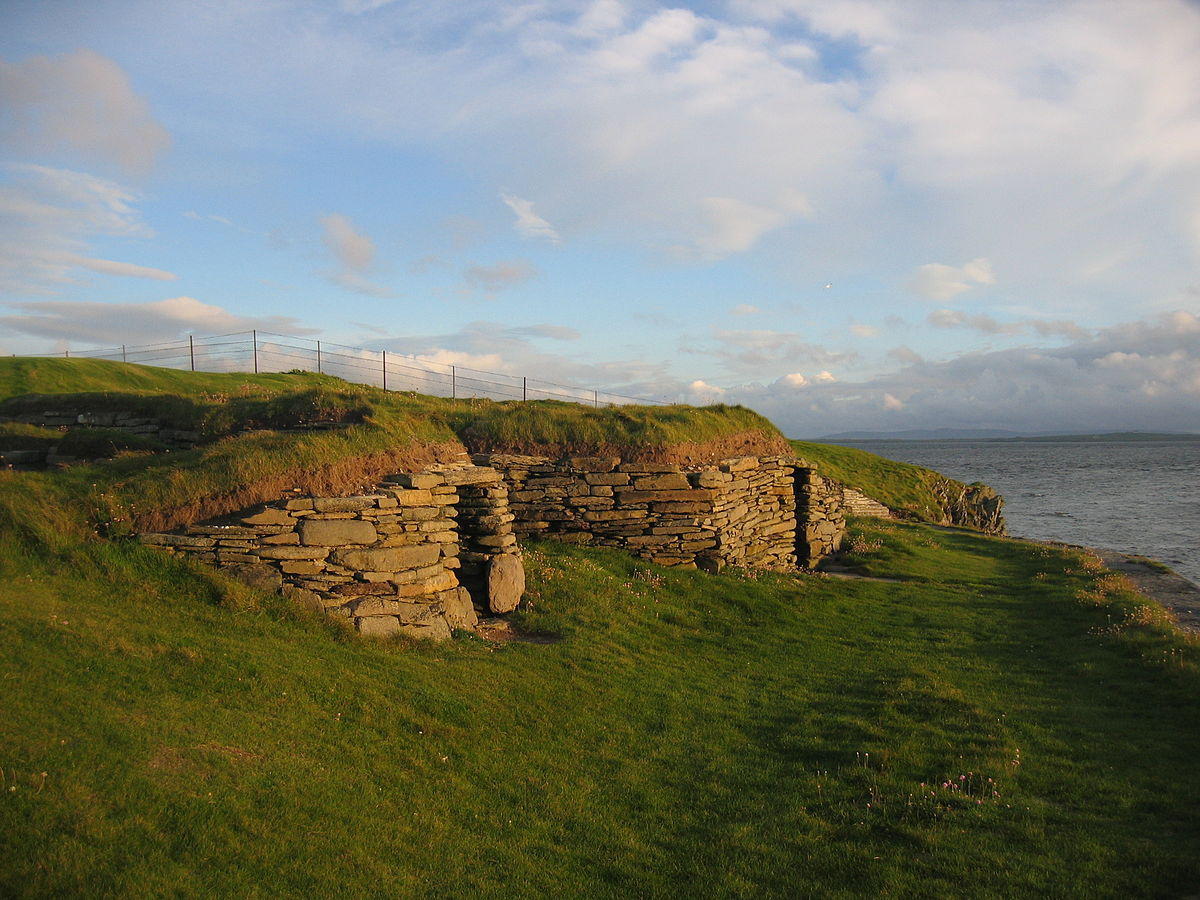 |
| Photo: Wikipedia |
Drop in on the oldest standing stone buildings in north-west Europe, occupied more than 5,000 years ago. ‘
The Knap of Howar consists of two ‘houses’ with surviving stone cupboards and stalls. They date back to the third millennium BC – contemporary with Orkney chambered tombs, such as Midhowe.
The two houses are the best preserved and most visible early Neolithic settlement anywhere in north-western Europe.
Orkney is home to some of the most outstanding examples of prehistoric domestic and funerary architecture in Europe. The Heart of Neolithic Orkney World Heritage Site – comprising the slightly later Neolithic settlement at Skara Brae, the Ring of Brodgar, the Stones of Stenness and Maeshowe tomb – sits within a wider prehistoric landscape.
This includes the multi-phase prehistoric settlement at Links of Noltland on Westray and the chambered cairn at Holm of Papa Westray, where the inhabitants of the Knap may have been buried.
2. Megalithic Temples of Malta
 |
| Photo: Dave's Travel Pages |
The Megalithic Temples of Malta (Maltese: It-Tempji Megalitiċi ta' Malta) are several prehistoric temples, some of which are UNESCO World Heritage Sites, built during three distinct periods approximately between 3600 BC and 2500 BC on the island country of Malta. They had been claimed as the oldest free-standing structures on Earth until the discovery of Göbekli Tepe. Archaeologists believe that these megalithic complexes are the result of local innovations in a process of cultural evolution. This led to the building of several temples of the Ġgantija phase (3600–3000 BC), culminating in the large Tarxien temple complex, which remained in use until 2500 BC. After this date, the temple-building culture disappeared.
The Ġgantija temples were listed as a UNESCO World Heritage Site in 1980. In 1992, the UNESCO Committee further extended the existing listing to include five other megalithic temple sites. These are Ħaġar Qim (in Qrendi), Mnajdra (in Qrendi), Ta' Ħaġrat Temples (in Mġarr), Skorba Temples (in Żebbiegħ) and Tarxien Temples (in Tarxien). Nowadays, the sites are managed by Heritage Malta, while ownership of the surrounding lands varies from site to site.[9][10] Apart from these, there are other megalithic temples in Malta which are not included in the UNESCO World Heritage list.
1. Tumulus of Bougon, France
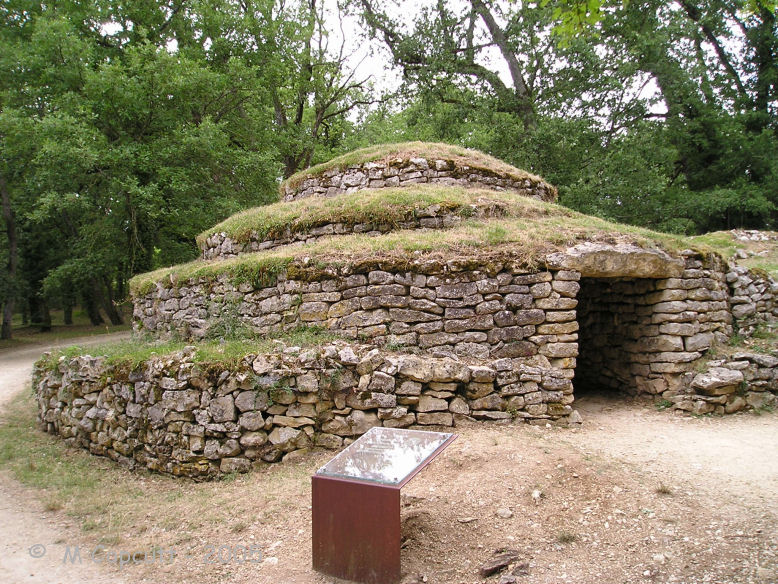 |
| Photo: The Megalithic Portal |
The tumuli of Bougon, also called the necropolis of Bougon, is an archaeological site dating back to the Neolithic period formed by five burial mounds, located in the vicinity of La-Mothe-Saint-Héray, France.
The tumuli of Bougon, also called the necropolis of Bougon (in French: tumulus de Bougon, nécropole de Bougon) is an archaeological site dating back to the Neolithic period formed by five burial mounds, located in the vicinity of La-Mothe-Saint-Héray, in the Poitou-Charentes region, France.
The discovery of the site in 1840 aroused great interest in the insides, and to protect the monuments, the site was acquired by the department of Deux-Sèvres in 1873. In the sixties of the twentieth-century excavation activities were resumed.
The oldest structures found in the complex date back to 4,800 BCE.
The tumuli are divided as follows:
Tumulus of Bougon A
Tumulus of Bougon B
Tumulus of Bougon C
Structure D
Tumulus of Bougon E
Tumulus of Bougon F
 Top 10 Most Handsome Billionaires In The World Today Top 10 Most Handsome Billionaires In The World Today Is there also beauty behind money? Are the rich men also handsome and attractive? The answer is definitely yes. Check out the 10 Most Handsome ... |
 Top 10 Most Beautiful Places to Visit Around the World Top 10 Most Beautiful Places to Visit Around the World What is the most beautiful place on earth? From countries all around the world, these are our top 10 most beautiful places to visit. |
 Top 10 Most Expensive New Cars In The World Top 10 Most Expensive New Cars In The World Discover the most expensive new cars in the world and their special features. |
 Top 10 Most Handsome Arab Men In The World Top 10 Most Handsome Arab Men In The World Arab men are famous for their beauty. Who are the most handsome Arab men in the world? Let’s explore. |


























